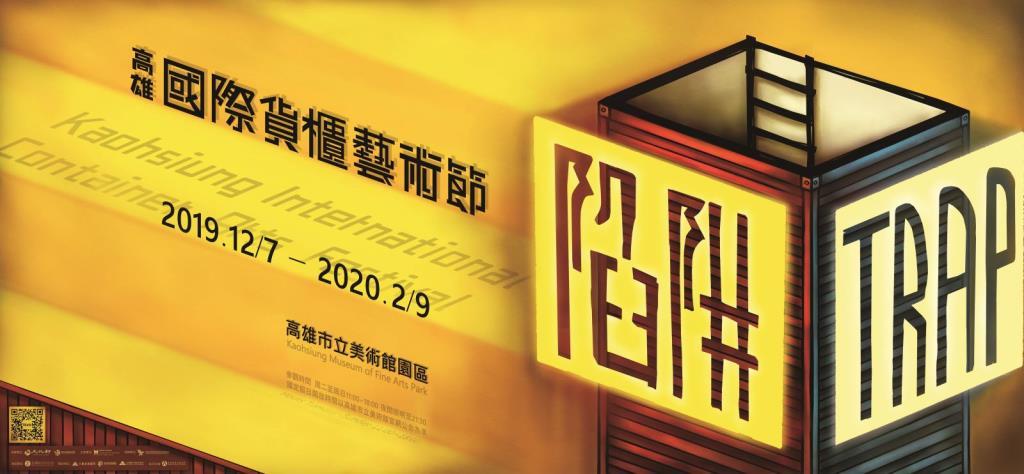
The Place of Trap
Taking the theme of “trap”, the 2019 Kaohsiung International Container Arts Festival is intended to indirectly raise a question to modern people. Nowadays, we are living a highly industrialized and modernized life with advanced information technology. We have taken many things and conveniences we are having in daily life for granted. However, what if all our current possessions and conveniences were gone, what kind of life will we have then? With the hypothetical theme of “trap” for the Festival this year, artists take viewers on an adventure on a material and/or spiritual level to find an answer to this question and find the destination of life for themselves.
Let’s imagine: Our life is retrograded back to its most primitive form in which we have to meet the most fundamental need for survival by finding and collecting food all by ourselves. There is no monetary currency or supermarket. We have to obtain food mostly through our labor or intellect. Living in cities where people are alienated from one another, we may envy the collective lifestyle of living together as whole that still exists in indigenous communities. Through their sharing of food and division of work, they are able to continue their bloodlines and cultures. They serve as a model of utopian society for modern civilizations. During the era of bartering, did humanity compete or cooperate in order to survive? In the present days with physical or virtual currency, convenient life at the material level does not necessarily bring spiritual richness; as a result, more and more people are longing for life back in the wild fields and mountain forests.
In the Festival this year, we construct a virtual dialogue between wild jungles and urban jungles, discussing freely about the “trap”—its concrete existence (at the substance level) and its conceptual nature (at the abstract level). However, traps are often hidden and come in a diverse variety of forms. How can we identify them and avoid being trapped? The issue of the “trap” is taken both lightly and seriously in the Festival this year with the participating artists deepening their discussions through their works about “traps” in different domains of life, such as culture, human rights, land, politics, economy, and society.
A 10-Year Milestone of the Festival
The Kaohsiung International Container Arts Festival is a major biennial art event held in Kaohsiung since 2001. The year 2019 is an important milestone marking its 10th anniversary. Containers, a reminder of the once prosperity of Kaohsiung Port with busy cargo throughputs, are used by the artists as the main element or carrier in their works for the Festival (from 2001 to 2011). In The Inhabitables (2013) and Ark of Tomorrow (2015), artists used containers to express their imagination about future home spaces and their brilliant aesthetic creativity, drawing references from the common practice of converting containers into makeshift spaces for daily use in Taiwan. In the Silver Horizon (2017), artists used containers to convey their responses to Taiwan’s aging society, regarding each of decommissioned containers as a symbol of one’s life journey and then giving the containers a new form of life through artistic creativity. In the 2019 Kaohsiung International Container Arts Festival, artists from Taiwan and other Austronesian islands are invited to express their celebration of and responses to civilizations, mountain forests, oceans, and primitive life styles.
A Place Waiting for You
The theme of “trap” is also an attempt of KMFA to review what it has learned from its focus on contemporary Austronesian arts over the past 10-odd years. We especially invited Sakuliu, Peleng Pavavaljung and Suliape Pulidan to join our work team. The inclusion of their cultural contexts stimulates and deepens our understanding of Austronesian cultures. Lu Chien-ming, an architect who was earlier responsible for the vegetational planning and design for the Austronesian Park of KMFA, led a group of indigenous students in the construction of a rest space for the participating artists in the Festival using materials available on site and traditional indigenous construction techniques of binding and joinery. The “Place Waiting for You” designed by Sakuliu Pavavalung, Art Director of the Festival this year, provides a comfortable and soothing space where visitors can access information of the performances and activities in the Festival. Through the repeated sessions of discussion and deliberation with the artists about their proposals in the Consensus Camp we held during the exhibition preparation period, we have become deeply aware that “trap” is an never-ending topic, just like the development and evolution of history which immediately moves on to the next past-present-future cycle right after the completion of a past-present-future cycle. However, who will stand at the helm in charge of future development directions? It all depends how much confidence we have in our own cultures!
Last but not least, much gratitude is owed to Mr. Tseng Chih-yung, Director-General of the Indigenous Peoples Culture Development Center for his full support to the Festival this year, and to Mr. Tseng Yao-Sheng, President of Delta Design Corporation; Mr. Hounded Chen, President of Chen Mei Development Group; and Mr. Lin Ming-che, Chairman of the Mountain Art Foundation for sharing their rich experiences accumulated over many years in visual art and performance art, which has helped to enrich and enliven the performances in the Festival this year.
Artists
尤瑪‧達陸 Yuma Taru
雷凱‧津宜 Rakei Kingi
魯碧‧司瓦那 Roby Swana
巴豪嵐‧吉嵐 Cil-Lan Pa Hao Lan
尼誕‧達給伐歷 Nitjan Takivalit
達比烏蘭‧古勒勒 Tapiwulan Kulele
安聖惠(峨冷‧魯魯安)Eleng Luluan
飛魚‧密斯卡 Flyingfish Meysega
雷恩 Kulele Ruladen
瑪籟‧瑪卡卡如萬 Malay Makakazuwan
尼古拉‧莫雷 Nicolas Mole
Nakaw Putun
伊祐.噶照 Iyo Kacaw
勒嘎.舒米 Lekal Sumi Cilangasan
哈拿‧葛琉 Hana Keliw
藍調織女A’talan
部落織女:鄭玉花 Miko•Lihom
陳美惠 Cimiko•Caki
施翠美 Fuyuko
余玫玲 Isak